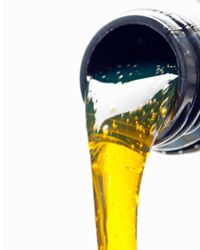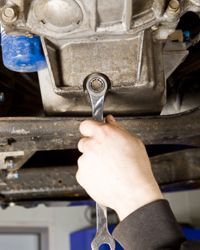\”

You can clean the exterior of your car as often as you like, and nearly every time, there will probably be a chunk of gunk or smear of grime that makes you ponder its origins — that is, until you become too disgusted by the thought. So you get the car nice and clean, and maybe go for a relaxing drive to celebrate a hard afternoon\’s work. But do you ever think about what your car looks like under the hood? And not just on the surface, but inside?
There are practical reasons, other than pride, to keep your engine clean. A dirty engine littered with debris and motor oil deposits will lose horsepower and run less efficiently. And though motor oil is the cause of a lot of engine buildup, part of its job is to remove and prevent that harmful gunk. In this article, we\’ll help you figure out how to get the most from your motor oil — without leaving a lot of it behind.
Contents
- Understand How Motor Oil Deposits Are Formed
- Don't Fear Paraffinic Waxes
- Don't Assume Using Synthetic Oil Will Prevent Buildup
- Change Your Oil at the Proper Interval
- Follow the Manufacturer's Recommendations
5: Understand How Motor Oil Deposits Are Formed


When you understand how and why motor oil deposits get lodged in your car\’s engine, you\’ll better understand the qualities and properties of the various oil options on the market, and the importance of choosing the right product for your car.
According to oil marketing company Castrol, the top causes of oil-related engine deposits are:
- Excessive idling and lots of short trips, which prevent the oil from fully cycling
- Environmental contaminants in the oil (like dirt and debris)
- Condensation, which can contaminate the oil with moisture
- Hot spots, which bake clumps and oil right onto the engine
There are several different types of engine buildup, not all of which are caused by motor oil. Even when buildup is caused by another problem (condensation or leaky seals, for example), your engine\’s oil can contribute to the problem because as it circulates, it distributes contaminants and foreign fluids throughout the entire engine.
Buildup is actually comprised of unburned and partially burned fuel, metal fragments from engine component wear and dirt and debris that find a way inside your car\’s engine. Deteriorating piston rings and seals allow partially combusted fuel to escape, which also causes buildup. The deposits are carried through the oil until they find somewhere to settle, restricting or blocking the surrounding oil flow, which causes increased engine wear. Deposits are thick and gummy as they form, and often harden once they settle somewhere in the engine. Heat from the engine will quickly cook the deposits solid, and once a blockage spot is established, new buildup will often settle on top of it instead of allowing the oil to flow around it. Soon, there are hard layers of grime, which are difficult to remove. Prime targets for various forms of deposits include the fuel injectors, piston rings and valves, all of which will interfere with the engine\’s smooth and efficient operation.
In addition to its lubricating properties, oil helps clean the engine and prevent new deposits by dissolving sediment buildup and capturing debris.
4: Don't Fear Paraffinic Waxes


Part of the reason people are so confused about motor oil deposit causes is that there are a lot of myths about specific types of oil. One of the most prevalent is that paraffinic oils are a leading cause of deposits because of the natural waxes these oils contain. This belief does have an element of truth, so let\’s examine the makeup of natural oils.
Crude-based (mineral) oil is made in an oil refinery from natural resources. Crude oil provides the components for all oil-based products, including mineral motor oils. At the refinery, the crude is broken down into different components (like gasoline and kerosene); motor oil is only one of the end products. Crude oil is extremely valuable because it\’s a non-renewable natural resource — when we run out, it\’s gone for good.
The term paraffinic (paraffin-based) describes a type of crude oil. Motor oils made from paraffin-based crude have a reputation for causing deposits in the engine, because wax is one of its major components. However, oil manufacturers remove as much of the wax as possible during the oil refining process, since the wax offers no benefit to motor oil, but it\’s valuable for making other products.
That said, some wax does remain; it\’s simply too expensive and inefficient to keep re-purifying the oil to remove all possible traces of paraffin. For a relatively inexpensive mass-market product like motor oil, it\’s just not worth it. So, the paraffin-based motor oil on the store shelf will contain minuscule amounts of wax. It\’s true that, at low temperatures, these small amounts of residue can clump into crystals, but this is far from the catastrophic greasy deposit-forming coating that many people fear.
Now that we know some of the downfalls of crude oil, you might be wondering about your alternatives. There\’s always synthetic oil, and though the name just sounds cleaner and more scientific, it might not necessarily solve all your problems.
3: Don't Assume Using Synthetic Oil Will Prevent Buildup


As we\’ve already seen, consumers have a lot of options when it comes to oil, and as you know, mineral or synthetic is one of the first decisions that must be made.
Crude-based oils, because of their natural origins deep within the earth, contain sulfur and other undesirable or harmful contaminants. A lot of these pollutants are removed from the oil during the refining process, but it\’s impossible to completely purify a mineral-based oil; it\’s simply too expensive and, thus, impractical, to design and invest in machinery that will filter the oil to a completely pure form. As we mentioned earlier, the remaining contaminants are one of the causes of motor oil deposits.
Synthetic oils, though much more expensive than their mineral-based counterparts, offer some advantages. Since they\’re not derived from fossil fuels, they don\’t deplete non-renewable natural resources. And because they\’re designed by chemists, they can be custom-blended to meet specific automotive needs, no matter how demanding. So if you decide to invest in synthetic oil, weigh the costs and benefits carefully. But while lab-engineered oil might be cleaner than crude-based, it\’s not still perfect.
Synthetic oil manufacturers want you to believe that their products are a miracle salve for every engine on the road. Synthetics do offer a lot of benefits over mineral oil, hence the much higher prices, so it\’s tempting to think you can make the investment but stretch a bit farther between oil changes. Bad idea, says Mike Allen of Popular Mechanics. Your engine might be a bit healthier if you\’re running synthetic, but gunk will still build up and cause problems. Stick to the manufacturer\’s recommended change interval, usually 3,000 to 5,000 miles (4,828 to 8,047 kilometers) [source: Allen].
2: Change Your Oil at the Proper Interval


Conventional wisdom holds that you should change your oil every three months or 3,000 miles (4,828 kilometers), whichever comes first. That isn\’t necessarily true in every case — some cars, and some oils, can go longer between changes, while others (like race cars, for example) should be changed more frequently. (Follow your manufacturer\’s recommendations for the proper interval.)
The "whichever comes first" bit is true, though it\’s often disregarded. So why is it important to change the oil so regularly, even if it\’s been sitting in a car that hasn\’t been driven?
Motor oil is subject to a condition called oil viscosity breakdown, in which the oil\’s structure gets damaged as it does its job. When the car is driven, the oil circulates through the engine, mashed between the grinding gears and other moving parts. The oil does its job by preventing extremely harmful metal-to-metal contact, but in the process, it\’s absorbing the brunt of all that moving metal. These conditions quickly destroy the oil\’s thickness, or viscosity, which is one of the oil\’s main qualities. (The viscosity is so important that oils are categorized by viscosity — it\’s another way of describing the "weight" — the numbers that you use to buy oil based on your manufacturer\’s recommendation.)
Once the oil starts to break down, it\’s increasingly less able to do the hard work of lubricating the engine. The oil\’s numerous additives and detergents also suffer over time — they evaporate, they lose potency, or they\’re simply used up. So as the oil\’s lubricating properties are diminished, it\’s also less able to clean the engine\’s surfaces, help your fuel economy, trap contaminant particles, condition the engine\’s seals and generally keep your car in peak performing condition. The risk of saving a few bucks on an oil change doesn\’t seem worth it — why would you wait?
1: Follow the Manufacturer's Recommendations


Of course, this advice is all for naught if you\’re not using the right oil in the first place, so your safest bet is to find out what type of oil your car\’s manufacturer recommends. Your car will perform best using certain types of oil, and if your car is new and still has a manufacturer\’s warranty, the engine coverage might be voided if you stray from your manufacturer\’s specifications.
Your car\’s owner\’s manual will specify if you should use synthetic or mineral-based oils. If you have a car with a high-performance engine, it\’s especially important to use a designated premium oil to prevent debris buildup. But beyond the oil\’s source, there are other qualities that affect engine performance, and it\’s wise to trust the people who designed and engineered your car.
Viscosity is the next most important factor. As we mentioned earlier, it\’s what is meant when discussing oil\’s "weight," but it\’s slightly more complicated than that. Different types of engines are built with different tolerances. Put simply, tolerance is a measurement of how the moving metal parts interact as the engine churns. A tight (or low) tolerance generally means the engine\’s parts mesh very closely together and there isn\’t much margin for error. This is particularly important with big, expensive high-performance engines. Less-expensive engines, common in small or economy cars, might have a slightly higher tolerance. So, what does this mean for motor oil? Well, the oil has to fit between all those meshing parts to prevent extremely harmful metal-on-metal contact. A viscosity designation will tell you (using an industry-standardized rating system) how thick the oil is and how well it flows (if it slips easily through the engine or forms a thicker, more clingy coating). Some oils are highly vulnerable to temperature changes; others are a bit hardier. But your owner\’s manual will specify what oils you should use to help your car perform best in different seasons and different weather conditions.
Also, manufacturers market their oils with specific additives to customize their products for different types of cars, varying weather conditions and different driving purposes — like high-mileage cars, stop-and-go commuting or even racing applications. These oil additives include conditioners that lubricate the seals to prevent passage of debris, and detergents that help clean. Detergents are there primarily to prevent deposits. They\’ll also inhibit rust and corrosion inside your car\’s engine, and may help dissolve existing buildup before it becomes a problem. Dispersants break down buildup and suspend the particles in the oil so, as the oil flows, the contaminants can be caught by the filter. But some experts warn that oil additives might not be as helpful as promised. In fact, they tend to have a limited lifespan that won\’t really be beneficial beyond the oil change interval, anyway.
For more information about motor oil and other ways to keep your car\’s engine healthy, follow the links on the next page.
Lots More Information
Related Articles
- 5 Driving Tips to Prolong the Life of Your Engine
- 5 Benefits of an Engine Flush
- 5 New Gas Engine Technologies
- Car Smarts: Engine Performance
- Car Smarts: Fuel Injections
- How Horsepower Works
- How Superchargers Work
- How Turbochargers Work
- How Camshafts Work
- Is anyone developing lifetime engine oil?
- Is premium gasoline really better for luxury vehicles?
Sources
- Allen, Mike. "5 Car Maintenance Procedures You Don\’t Need." Popular Mechanics. Oct. 1, 2009. (May 11, 2011)http://www.popularmechanics.com/cars/how-to/4220245?click=main_sr
- Allen, Mike. "Synthetic or Mineral Oil? Setting the Record Straight (Finally)." Popular Mechanics. Nov. 1, 2007. (May 8, 2011)http://www.popularmechanics.com/cars/how-to/products/4232672?click=main_sr
- Castrol. "Is Your Car Engine Happy and Healthy?" April 18, 2005. (May 14, 2011)http://www.castrol.com/castrol/genericarticle.do?categoryId=9014427&contentId=7012452
- Havoline Motor Oils. "Conventional Oil, Synthetic Blend, Deposit Shield." 2011. (May 11, 2011)http://www.havoline.com/NA/products/motor-oils2.aspx?parent=motor-oils1.aspx
- Performance Plus. "Myths of Motor Oil." 2009. (May 11, 2011)http://www.performanceplusoil.com/myths.php
- Valvoline. "High Mileage Lubricants." 2010. (May 11, 2011)http://www.valvoline.com/products/brands/maxlife/full-synthetic-motor-oil/3
- Volvo Service Tips. "Engine Oil — Synthetic Oil; The Cost Benefit Analysis." (May 11, 2011)http://volvoservicetips.com/?p=250
- Weissler, Paul. "How to Pick the Right Motor Oil For Your Car." Popular Mechanics. Aug. 1, 2002. (May 8, 2011)http://www.popularmechanics.com/cars/how-to/products/1266801?click=main_sr












